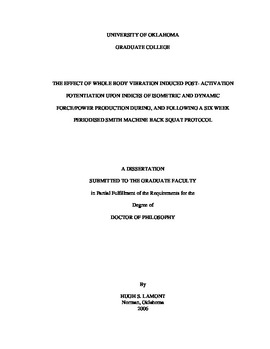| dc.contributor.advisor | Bemben, Michael G., | en_US |
| dc.contributor.author | Lamont, Hugh S. | en_US |
| dc.date.accessioned | 2013-08-16T12:20:17Z | |
| dc.date.available | 2013-08-16T12:20:17Z | |
| dc.date.issued | 2006 | en_US |
| dc.identifier.uri | https://hdl.handle.net/11244/1052 | |
| dc.description.abstract | Purpose. The purpose of this study was to examine the chronic and acute effects of a 6 wk, periodized Squat training program, with (G2) or without (G3) low frequency vibration upon select force characteristics, as well as to changes in body composition. Methods. Participants (G1 n = 6; G2 n = 13; G3 n = 11; ranged in age from 18 to 30 years) were randomized into either a 6 wk periodized Squat training regimen, with or without whole body low frequency vibration or a control group. Measures of dynamic and isometric strength (1RM Squats and Isometric Quarter Squats), dynamic power (Depth Jumps and Squat jumps with a 20 Kg load) and body composition (DXA) were assessed. Results. Both training groups increased significantly for the Squat 1RM from baseline to week 7 compared to the controls. There were significant group differences for Rate of Force Development at 250 ms, initial peak in force, and Peak RFD. There were also significant group differences for Force at 250ms, Force at initial peak, and MVC. There were significant differences in Peak jump power between G2 and G3 from weeks 1 to 3 under both jumping conditions. Both training groups had significant increases in total lean tissue, lean trunk tissue, and lean leg tissue (g), and significant decreases in percent leg fat. Conclusions. Whole body vibration did not improve maximal force generating capability beyond resistance training alone and actually lead to a decreased performance. | en_US |
| dc.format.extent | xii, 230 leaves : | en_US |
| dc.subject | Isometric exercise. | en_US |
| dc.subject | Human body Effect of vibration on. | en_US |
| dc.subject | Human body Composition. | en_US |
| dc.subject | Health Sciences, Rehabilitation and Therapy. | en_US |
| dc.subject | Health Sciences, Recreation. | en_US |
| dc.title | The effect of whole body vibration-induced post-activation potentiation upon indices of isometric and dynamic force/power production during, and following a six-week periodised Smith machine back squat protocol. | en_US |
| dc.type | Thesis | en_US |
| dc.thesis.degree | Ph.D. | en_US |
| dc.thesis.degreeDiscipline | Department of Health and Exercise Science | en_US |
| dc.note | Source: Dissertation Abstracts International, Volume: 67-05, Section: B, page: 2513. | en_US |
| dc.note | Adviser: Michael G. Bemben. | en_US |
| ou.identifier | (UMI)AAI3218124 | en_US |
| ou.group | College of Arts and Sciences::Department of Health and Exercise Science | |
